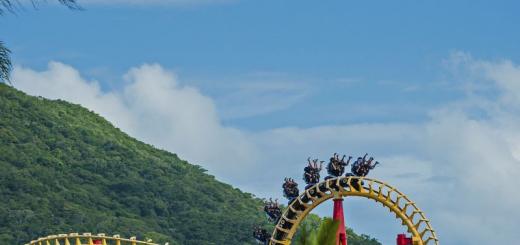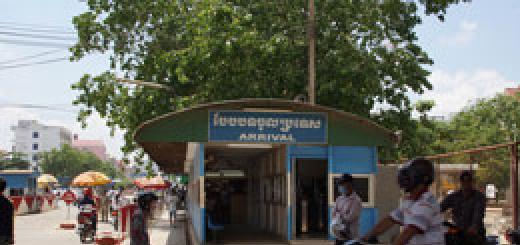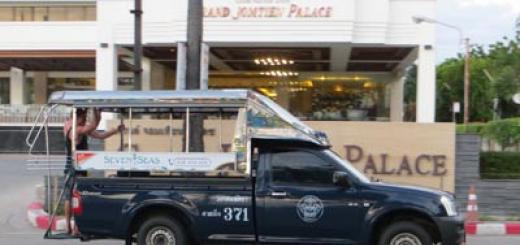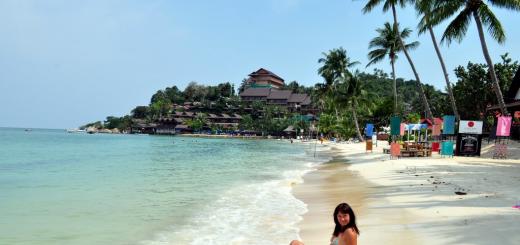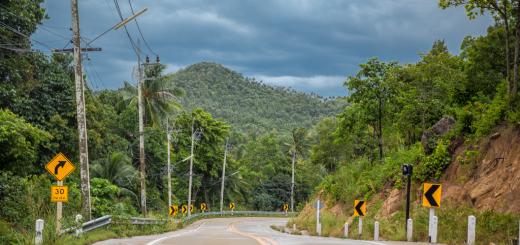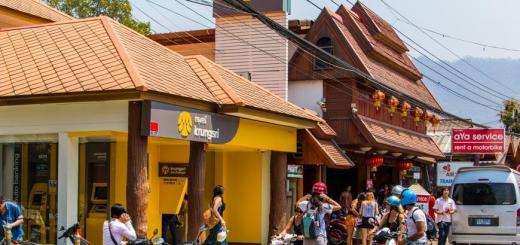Tuk Tuk is the name of public transport in Pattaya. A tuk tuk is a pickup truck with a covered body in which passengers sit. Getting around Pattaya by tuk tuk is safe and cheap. Tuk tuks go around all the main streets of Pattaya around the clock.
Tuk Tuk in Pattaya on Jomtien
What is a tuk tuk in Pattaya? This is a full-fledged public transport, which can be easily reached for symbolic money almost anywhere in the city on one route or with a transfer. Walk to all major shops and bus stations.
Features of tuk tuks in Pattaya
- A tuk tuk ride costs 10 baht (20 rubles / $0.3).
- Opening hours: around the clock. During the day they walk at short intervals of 1-5 minutes, less often in the evening.
- Do not look at the numbers, the routes depend on the street.
- You can catch a tuk tuk with a wave of your hand, like a taxi. Stop anywhere.
- There are no glasses in the cabin. In case of rain, the film is lowered. You can ride on the rear platform while standing outside.
- Do not sit sideways (a sign of a tourist). Sit up straight, don't put bags on the seat, and always move over so other people can sit too. Put a small child on your knees if there are a lot of people.
- To exit, press the bell button on the ceiling.
- Pay the fare to the driver when you exit through the front window. It is better to pay in small money, as change can sometimes be “accidentally” undercounted.
- If the driver suddenly turned off the route on a whim, you have to get out and catch another one. It is useless to argue, do not waste your nerves. For example, often tuk tuks do not go to the end of Jomtien or do not go from the center to Wongamat, but turn to the beach. There is no logic, just take it for granted.
- Can work as a taxi. Average prices are from 150 to 300 baht per car or 50 baht per person.

Photo of a typical Pattaya tuk tuk cabin
Tuk tuk routes in Pattaya
Tuk-tuks operate on all main streets of the city. In the center, at the beginning of almost every major street, there is always a tuk-tuk picking up people. If you sit in it, then you can drive along this street to the end.
On Jomtien, songthaews run along the entire length of the beach street. In central Pattaya along the beach street and along the second and third from the sea, as well as along three vertical streets to Sukhumvit. In the Naklua area and Wongamat beach, there is only one route along the main street. There are no routes in the Pratumnak and Cozy Beach area.
1. Route "Jomtien - Central Pattaya"
 This tuk tuk can be reached from Jomtien:
This tuk tuk can be reached from Jomtien:
- To Tesco Lotus and Teprazit Market (with transfer to Teprazit Road)
- To Central Pattaya: Walking Street, Tukkom store, Central festival shopping center, Big C and Terminal 21
- On the pier to the ferry to Koh Lan (need to walk through Walking Street)
- To Wongamat Beach (most often with transfers)
The route runs along the entire beach street in the area. It starts in different ways, sometimes from the police station at the intersection with Chayapryek Street, and sometimes a little further south, in the Na Jomtien area. Tuk-tuks that travel back from the center do not always take them further than Chayapryek Street. In this case, if you need to go further, just get out and wait for the next one.
Route map "Jomtien - Central Pattaya"
The terminal in the center of the PTT is most often at the roundabout with dolphins. Occasionally can travel further to the Naklua area.

Crossroads with dolphins on the map
The stop to travel back to Jomtien is at the intersection of Second Street and South Street. This is the southern part of central Pattaya, not far from Walking Street. There are always a lot of tuk-tuks, just take the last one where other people are sitting.
Tuk-tuk stop towards Jomtien
2. Route along Teprazit Road
 This route is used by everyone who lives in Jomtien and Pratumnak. Where can you get to:
This route is used by everyone who lives in Jomtien and Pratumnak. Where can you get to:
- In a big Tesco Lotus
- In the sports center Outlet Mall
- Teprazit night market
- At the fruit market near the Colosseum
- To Sukhumvit Highway to change to a white tuk tuk towards Ambassador
It starts at the beginning of Thep Prasit road, not far from Foodmart. It goes to Sukhumvit, where it turns around near the Outlet. Sometimes on weekends it can turn around a little earlier, near the night market. Stop in the opposite direction near the taxi drivers in front of the Outlet.
Tuk tuk route along Teprazit street
3. Route "Central Pattaya - Wongamat - Naklua"
 The route connects the northern regions of Pattaya with the center and south. On this bus you can travel:
The route connects the northern regions of Pattaya with the center and south. On this bus you can travel:
- From the center to the Naklua area
- To northern beaches: , Crescent Beach, Wong Prachan
- To the Temple of Truth and the Palace of the Chicken King
- From Wongamata you can get to the shopping center Terminal 21, Central Festival and large supermarkets Tesco, Big C without transfers
- From Wongamat you can get to Walking Street without a change
The route starts from the Dolphin Crossing opposite Terminal 21 and runs along Pattaya Naklua Street approximately to the fish market. Wongamat does not go to the beach, it takes about 20 minutes to go to the sea from the main street. Back from Wongamat to the center, it goes the same way along Naklua street, passes through a new shopping center, turns around and then moves along the beach road (Beach Road), past Central Festival to Walking Street.
Scheme of the movement of tuk tuks "Central Pattaya - Wongamat"
4. Tuk-tuk routes in Central Pattaya
There are several routes in the PTT center. On the beach street, Beach Road, traffic is one-way and minibuses go only in one direction from north to south, that is, in the direction of Volkin Street. Start from the intersection with dolphins. Terminus near the tuk-tuk stop on Jomtien.
On the second street from the sea, they drive in the opposite direction, from south to north.
The scheme of movement of tuk-tuks in the center of Pattaya along the Beach Road
Also in the center of PTT there are 3 streets from the beach towards the Sukhumvit highway - North, Central and South. They also run 10 baht songthaews.
Between the second and third streets, there is a pink lantern street, Soi Bakao. It also runs the songteo route. You can drive from the Tukkom and Friendship store to the main street (and then walk to the central Big C) or further to the beach in the area.
Where can I order a transfer from the airport?
We use the service - Kiwi Taxi
Ordered a taxi online, paid by card. We were greeted at the airport with a sign with our name on it. We were taken to the hotel in a comfortable car. You have already talked about your experience In this article.
5. White tuk-tuk on the Sukhumvit highway
 Minibuses also run along the Sukhumvit Highway. Where can you get on white tuk tuks:
Minibuses also run along the Sukhumvit Highway. Where can you get on white tuk tuks:
- To the park of miniatures
- To the aquarium Underwater World Pattaya
- To the floating market
- To the hotel and the beach and Mimoza shopping center
- To Cartoon Network Water Park
- Before the turn to Nong Nooch
- Before turning to Sai Keo Military Beach
A short distance ride within central Pattaya costs 10 baht, and if you go a little further, to the Ambassador, for example, then 20 baht per person. But most often now drivers require tourists to pay 20 baht per person. It's useless to argue, just pay and forget. Along the Sukhumvit track, not only whites, but also blue songthaews go. Blue only to the floating market (do not go to the Ambassador). The whites pass the Ambassador and continue on towards the town of Satahip. Where they have the final one is unknown.
White tuk tuk traffic map in Sukhumvit
Marks on the map at the beginning of the route and at the end are conditional, I don’t know exactly where it starts and where it ends. But at these points it definitely passes.
Pattaya map with tuk tuk routes
Such a card can be taken for free near many shops in Pattaya. I got this copy from Foodmart, I also saw such cards near 7-Eleven. In addition to the abundance of advertising, there is useful information about the city, all kinds of emergency phone numbers and a tuk tuk traffic map.

Scheme of the movement of tuk tuks in Pattaya
How to get there by tuk-tuk
I will use the route numbers in the order described in the article above to make it clearer.

Tuk-tuk as a taxi at the observation deck in Pattaya
In other regions of Thailand, this type of public transport is called songteo or baht bus. And the very word "tuk tuk" in Asian countries always means a motorcycle on three wheels that works like a taxi.
Public transport in Pattaya is something the resort can really be proud of. Personally, I have not yet met a single city in which the transport system would be more convenient and affordable than in Pattaya. Speaking of convenience, I primarily mean the ability to quickly get from point A to point B without any long delays and waiting at stops. During my first visit to Pattaya, I, like all unprepared tourists, was in some shock from the chaotic traffic and knew almost nothing about local transport, except that it travels along the First (Beach) street from north to south, and along the second - in the opposite direction. At the end of December 2016, local authorities established new tuk-tuk routes in Pattaya. A detailed article with maps is being prepared!
THE CONTENT OF THE ARTICLE (click on the link for a quick jump)
However, just a few days at the resort with active movement along the city streets and districts convinced me that transport in Pattaya is organized in such a way that without any problems it allows you to get from one end of the city to the other for ridiculous money (less than $ 1). In this article, I will describe in detail the routes of public transport in Pattaya and tell you how to get from one area to another as quickly and cheaply as possible. It will help me with this, which is published along with other maps of the city in the corresponding section of the site and duplicated here. The convenience of this map lies primarily in the fact that tuk-tuk routes in Pattaya, the main public transport of the city, are marked with color on it.
Map "Tuk-tuk routes in Pattaya" (click to enlarge)

What is a tuk-tuk in Pattaya
Unlike the three-wheeled tuk-tuks in Bangkok, the tuk-tuk in Pattaya is a more serious form of transport, which in reality is called songthaew (or songthaew), which means “two benches” in Thai. So the vehicle is called by the Thais themselves and experienced tourists, so I advise you to remember this word. Songthaews, or tuk-tuks in Pattaya, are Japanese pickups converted for passenger transportation, in the cargo compartment of which benches for passengers are installed along the sides, there is a roof and handrails. At the back of the songthaew there is a small step platform that makes it easier to get into the transport and on which several people can ride standing up if there are no empty seats on the benches.
Songthaew (tuk tuks) on Sukhumvit Highway
The indicated route is the longest and is marked in orange at the top of the map. The fare within Pattaya on one of the main highways of the country is 20 baht, regardless of the distance. A distinctive feature of tuk-tuks from Sukhumvit is their white color. The route runs far from most popular hotels and tourist areas, so you will most likely have to use the white songthaew to visit some of Pattaya's attractions on your own, to travel to individual shopping centers and large supermarkets in the city, to travel to the North and just to quickly move between areas of the city.
Tuk-tuk routes in Pattaya perpendicular to Sukhumvit Highway
Songthaeo routes, marked on the map in lilac, pink, dark blue and dark green, pass along North (North Rd.), Central (Central Rd.), South (South Rd.) and Thep Prasit Street perpendicular to the highway, which is located on the border with the administrative region of Pattaya Jomtien. The first three named streets connect Sukhumvit with the second street of Pattaya (Second Rd.) and divide the city into districts. A tuk-tuk ride on these streets costs 10 baht, but if after the final route the transport continues to move, you need to be prepared for the fact that you will have to pay 20 baht, because. it turns out that you are driving two fixed segments of 10 baht.
Tuk-tuks in Pattaya on Beach Road and Second Road
Songteo, which move along the main city beach of Pattaya, i.e. along Beach Rd. are marked in blue on the map. The initial stop of the route is the sculptural composition "Dolphins" (a flowerbed with a fountain at the intersection of Severnaya and Second streets), and the final stop is the gate at the beginning of Walking Street (hereinafter referred to as WS). Due to the fact that the route is in principle circular, i.e. after stopping at Walking Street, the tuk-tuk continues on Second Rd. (light green route on the map), sometimes you can sit in the center of the beach street and drive for only 10 baht to the same Dolphins. But this is not always convenient and possible, because. some free traffic often accumulates near the WS, and the songthaew can stand for a considerable time before the previously arrived tuk-tuks fill up with passengers.

Tuk-tuks to Jomtien and back
One of the most popular routes, marked in brown on the map, allows you to get from numerous hotels in the Pattaya Jomtien area without transfers to WS, as well as with one or two transfers to other objects in the central and northern parts of the city. The cost of the route is fixed and is 10 baht. I draw your attention to the fact that when a tuk-tuk moves further than the end point of the route marked on the map in the Jomtien beach area, it is often required to pay an additional 10 baht. Similarly, if you drive from Jomtien to the brown route terminus at the intersection of South and Second Streets and continue on the latter, the cost also increases to 20 baht.
IMPORTANT ANNOUNCEMENT:
WITH November 12, 2014 Jomtien Beach Road (the street along the Jomtien Beach promenade) is partially introduced one-way traffic for a period of one month (experiment to unload the street). More detailed information about the movement of tuk-tuks in this area of Pattaya will be posted a little later after the information is clarified. Keep in mind when looking for a hotel in this area or when planning a visit to the local Pattaya beach that there will be a little confusion with transport for some time, and getting to the center and back will not be as convenient as before 🙁
Currently (December 2014) the movement of the route from South Pattaya to the Jomtien area is carried out according to the old scheme, i.e. one-way traffic on Jomtien Beach Road cancelled.
Tuk-tuks on Naklua street
The songthaew route along Naklua Street is marked in yellow on the map (please do not confuse it with the yellow strip of sand on). The final points of the route are stops at Naklua Beach and at the Dolphins already mentioned in the article. As in previous cases, the tuk-tuk can continue moving in the direction you need after the end of the segment, while you need to add another 10 baht to the fare. This option is much more convenient than transferring to another tuk-tuk, but not always the tuk-tuk route can lead you where you need to go.
How to plan a route of movement around Pattaya on a tuk-tuk
When you need to get quickly from a point A to paragraph B with minimal cash outlay, a better option than tuk tuk in pattaya does not exist. In the first days of rest, you may still need a map of Pattaya with transport routes, but after a few days you will finally remember the routes and use them as a native of the city. How to create a convenient route for yourself? Just look on the map for the place you need to get to and the place where you are at the moment. Next, look for the nearest songthaew routes and figure out how to get to the right place with a minimum number of transfers. For example, you bought groceries at the Big C supermarket (red letter “C” on a green background in square K4 on the map) and you need to get shopping to your hotel in the Jomtien beach area.
 As you can see, the cheapest and most convenient option would be to go a little to the left of the store, take a tuk-tuk to the end of the "blue route" and immediately change to a tuk-tuk that will take you to the hotel along the "brown route". Total 1 change and 20 baht (10+10). And here is another option: you can take a white tuk-tuk and drive it to the intersection of Sukhumvit with Teprazit street, then transfer to the songteo, walking along the “dark green route”, where at the final one make another transfer to the “brown route” » In total, you get two transfers and 40 baht (20+10+10). It is clear that this option is more expensive and complex. But I haven’t mentioned yet that due to left-hand traffic in Thailand, you will have to cross the Sukhumvit highway twice, through which there are elevated pedestrian crossings with a lot of steps ...
As you can see, the cheapest and most convenient option would be to go a little to the left of the store, take a tuk-tuk to the end of the "blue route" and immediately change to a tuk-tuk that will take you to the hotel along the "brown route". Total 1 change and 20 baht (10+10). And here is another option: you can take a white tuk-tuk and drive it to the intersection of Sukhumvit with Teprazit street, then transfer to the songteo, walking along the “dark green route”, where at the final one make another transfer to the “brown route” » In total, you get two transfers and 40 baht (20+10+10). It is clear that this option is more expensive and complex. But I haven’t mentioned yet that due to left-hand traffic in Thailand, you will have to cross the Sukhumvit highway twice, through which there are elevated pedestrian crossings with a lot of steps ...
I hope that the principle of compiling routes is clear to you and does not cause difficulties. At the end of the article, I will note two points: transport in Pattaya also goes along other routes, i.e. some songthaews turn off the streets described in the article into alleys and other streets. It is not easy to distinguish them externally from those that need to be used without knowledge of the Thai language (writing). But, as I noticed, such tuk-tuks usually move closer to the center of the road, they don’t honk to tourists, but almost always only local residents ride them.
The second point is the routes indicated by me. In real life tuk tuks in pattaya from different routes do not have any color difference (with the exception of whites from Sukhumvit). This means that the designations “brown route”, “blue route”, etc., mentioned in this article. I cite for better orientation exclusively on a specific map posted at the beginning of the article. It is possible that being in Pattaya, you will find map with tuk-tuk routes where a completely different color will be used. I also consider it necessary to warn you that sometimes you have to sacrifice comfort for the cheapness of this type of transport: the benches in songthaews are sometimes quite hard, and you can accidentally hit your head on the metal handrails in the process of getting on and off.
I talked about moving around the city on more expensive modes of transport in the article, but for now, thanks for your attention, I hope the information was useful and you, being at the resort, will be able to use it successfully.
Thailand attracts millions of tourists with its golden sandy beaches and tropical palm trees. It will be difficult to move around the resort places of the country on foot in the heat, and the distance between the beaches is rather big. Public transport seems to be not an option, so people have to either rent it or use the services taxi in thailand. To understand the peculiarities of using each of all types of Thai taxi, you need to consider its types and cost.
Knock Knock
Tuk-tuk taxi in Thailand is one of the most popular means of transportation in resort areas. According to the services offered, it is somewhat similar to our minibuses, but they look like a mini-van with a canopy (roof).
Local drivers are constantly trying to upgrade their vehicle with a body kit, neon lights, and put chrome rims on the wheels. Usually, cheerful and loud music always plays in a tuk-tuk, often with such bass that you definitely won’t be bored on the road.

But all these charms do not mean that all tourists like tuk-tuks. And there are three reasons for this:
- Bad condition- among all the beautiful cars in Thailand, there are real rusty and dirty buckets that you just don’t want to sit in.
- Riding in the rain- no one will like this situation, in which a tuk-tuk, driving through puddles during the rain, will leave its passengers covered in mud, so it’s better not to ride in white.
- Safety- alas, a tuk-tuk is not a safe taxi at all, in case of a serious one, there will be many victims.

Moto sai
Moto-taxi (moto-sai) is considered the most common and mobile means of transportation in all of Thailand. In order to become a passenger of such a taxi, you need to agree with the driver. Cost may vary depending on distance and route. Often, bikers, as if forgetting about the passenger, begin to scorch and thereby endanger him. So you have to constantly remind him of you. Isn't it better to take in than to use their services?

Taxi Taxi meter
Taxi meter in Thailand is the usual passenger taxi. Most often, this type of transport is used to travel to the airport or hotel and back. Officially, they have meters, but few people in Thailand turn them on, and the cost depends on the resort and the route of the trip. The only downside to this Thai taxi- traffic jams, if tuk-tuk and bikes can easily go around them, then Taxi meter can not do it.

Transfers
 Another difference is the ability to order a minibus, provided that you are traveling in a large company and do not fit in an ordinary car.
Another difference is the ability to order a minibus, provided that you are traveling in a large company and do not fit in an ordinary car. How much does a taxi cost in Thailand?
Approximate cost for a tuk-tuk:- Phuket. Karon - Patong - 350 baht, Kata - Patong - 500 baht.
- Pattaya. Approximately for the same distance the price is 2-3 times lower.
- Phuket. Karon - Patong - 250 (300) baht.
- Pattaya. Likewise.
- Phuket. Airport - Patong 800 (900) baht, Karon - Kathu - 900 (1000) baht.
- Pattaya. Likewise.
Due to its insular location,
Transport in Phuket: how to get around, how to get from the airport to the resort, where to rent a moped or bicycle. As well as tuk-tuks, songteos, buses and other modes of transport in Phuket.
- Hot tours to Thailand
- Tours for the New Year Worldwide
Phuket is not just large (about 50 by 20 km), but also a relief island covered with many hills and mountains, which means long serpentines of roads winding between hills and bays. And if you have not flown to Phuket to spend two weeks at the hotel pool, the issue of transport will arise very soon. So what do we have? Three and a half city buses, a dozen minibuses, a municipal shuttle bus to the airport, a sightseeing pseudo-tram, ferries and boats, taxis, motorcycle taxis, tuk-tuks and rentals. The list may seem impressive, but let's see if the first impression is deceptive.
city buses
Many towns and villages are scattered around the island, but Phuket Town is considered to be the administrative, cultural, commercial and general center. It is on its streets that city buses run.
It is difficult to recognize a bus in Phuket for an unusual person - it is a converted pink truck with a tin roof, the body of which is equipped with three long benches, the windows are covered with tarpaulin or film only in case of bad weather, and there are no doors at all - an open entrance is located at the back.
The conductor in the cabin collects the fee: regardless of the number of stops, they will take 25 THB, they can issue a ticket, or they can forget it. You should not worry about this: no one here will expose you to fines.
There are bus stops in Phuket, but sitting there waiting for transport is not the best option. When you see a pink truck, wave your hand to it and attract attention in every possible way. Stops - on demand: press one of the bells on the roof or on the handrails. The bus will stop as soon as traffic rules allow.
Buses run on three very confusing routes, as intricate as the traffic on the streets of the Town. All routes go to the old bus station in the city center or stop nearby. Route number 1 passes by the popular shopping center Central Festival. The second one can be reached from the old bus station to the new one on the northern outskirts of the city, from where most intercity bus services depart. Bus number 3 will deliver from Phuket Town to the southwestern outskirts - the town of Koh Sire. There are several marinas with ferries to the nearest islands, you can rent a boat or dine with fresh seafood in a restaurant right on the seashore.
Having climbed into the cabin, check with the conductor whether the bus is going in the right direction, clearly and clearly naming the desired point of arrival.
The main disadvantages of city buses are the lack of a clear schedule between cars on the route and limited operating hours: from 6:00 to 19:00.
Previous photo 1/ 1 Next photo

Songteaw and minibuses
A person without personal transport to view all the main beaches of Phuket will have to seriously spend money on a taxi or wander between his hotel and Phuket Town. It is from the old center that the blue trucks and songteo pickups (literally: “two shops”) diverge to distant areas and beaches of Phuket. The fare is 40-60 THB depending on the distance. You need to pay with the driver, going to the cab at the exit. Just like on a bus, call the driver if you want to get off. Prices on the page are for October 2018.
There are no conductors in the songteo - do not try to give money to your neighbors in the cabin. They can take.
The main disadvantages of the songteo are its small capacity, as well as the complete absence of any schedules and schedules. Often the driver will not budge until he has reached the optimal number of passengers in his opinion, so the wait can be delayed. And vice versa - on weekends, the last songteo can leave the distant and popular beach as early as 14:00, leaving unlucky tourists to be torn to pieces by taxi drivers. Arriving at the beach, ask the driver several times, and preferably two, when the last songteo leaves for Town. Practice shows that they will not deceive you, even if it can harm the business.
Previous photo 1/ 1 Next photo


Routes passing through the major villages and districts of Phuket operate from approximately 7:00 am to 6:00 pm. The small capacity of songteo pickups is good when you are waiting for departure at the final, but keep in mind that local residents actively use this transport, sometimes carrying an incredible amount of trunks, basins and bags. So it’s not enough to catch the right songteo on the track, you still have to squeeze into it.
The only really big bus, similar to the younger coloring songteo brothers, runs from Town to Patong. There are enough places in it, it departs according to the schedule, which can be clarified with the driver or his assistant.
Also, more recently, comfortable air-conditioned minibuses run from the old bus station in Town to Patong. Unlike private songthaews, white and green minibuses run strictly on schedule: every hour from 7:00 to 18:00 from the bus station and from 6:00 to 18:00 from Patong. Tickets cost from 30 to 50 THB.
Bus "Airport - Phuket Town"
From the old bus station to Phuket Airport, the city's orange bus runs daily. Departure from the bus station from 6:00 to 18:30, from the airport - from 8:00 to 20:30. A detailed schedule can be found on the bus website. This type of transport does not have to be considered exactly as a bus to the airport: it can be used to get to the Phuket outlet, the Heroine Monument or the Thalang area. As with other buses on the island, it is possible to stop on demand. The cost of a full trip is 100 THB, they do not ask for a separate fee for luggage.
tuk tuks
In Phuket, there are almost no motorcycle-based tuk-tuks. Fashionable freshly painted micro-trucks of red, blue, yellow and green colors are common here, designed for a company of 6-8 people. The main difference between a tuk-tuk in Phuket and its counterparts from other cities and resorts in Thailand is the price. A Phuket tuk-tuk driver will not take you up for less than 300-500 THB, even if we are talking about moving within the same beach. This type of transport is good for a large cheerful company led by a person who knows how to bargain. But for two, it's a little pricey. As a result, tuk-tuks often stand idle near the beaches or drive empty through the streets, luring tourists with colorful lights and loud music.
sightseeing tram
In the fall of 2015, a sightseeing tram, or rather, a car stylized as a tram, passed through the streets of Phuket Town for the first time. Departure point - park them. 72nd birthday of Queen Sirikit. "Tram" makes a circle around the historical center of the city. You don't need a ticket, it's free. It operates 6 flights per day: at 9:00, 11:00, 13:00, 14:00, 15:00 and 16:00.
Taxi
Taxi drivers in Phuket are intractable and greedy. Especially in tourist places remote from the center and at a time when songthaews can no longer be expected. And if you are careless and report the urgency of the trip, then the price may “suddenly” increase. Prices for reference: a trip from Karon to Patong will cost 400-500 THB, for delivery from Patong to Town they can ask 500-800 THB, from Naiharn and Rawai to the airport up to 1500 THB.
To understand the prices for trips between different points, you can play with the calculator on the website of any of the companies offering online taxi orders. Armed with this knowledge, try to negotiate with the driver on the street: put in the amount of bargaining opportunities, but stand on your price to the last.
If you want to comfortably spend several hours exploring the island, stopping for memorable photos at viewpoints, it makes sense to arrange with a representative of your hotel, condo or just a Thai acquaintance about renting a car with a driver. Any of them will surely have a relative who, for 1000-1200 THB, will ride you for 3-4 hours along the chosen route.
Mototaxi
On the very first day of your trip to Phuket, you will see moped riders in vests of different bright colors. This is a common, fast and affordable way to move around the island. The cost of the trip depends on your perseverance and willingness to bargain: where a taxi driver in a car will take 500-600 THB for the opportunity to stand in a traffic jam (and they cannot be avoided on a paradise island), a motorcycle taxi will drive for 100-200 THB, avoiding traffic jams along the side of the road and motorcycle lane. Short distances within the same area will cost 30-50 THB.
These taxi drivers are picky, accommodating and take even two people with bags and backpacks to give a ride. You don't even need to catch them - they will catch you. And don't be squeamish about the proposed helmet: it's easy to wash your hair, and in the event of an accident, it's better to break the helmet than your head. Be sure to hold on to the driver or the handles of the moped, and if you are afraid, then ask in advance not to go too fast.
Water transport
There is no centralized water communication between the districts of Phuket, but on any beach you can rent a capacious Thai longtail boat. These boats are usually designed for 8-10 people. The price is negotiable, depending on the benevolence of the boatman, the number of your company and the season. For example, on Bang Tao Beach, for an hour of walking and snorkeling at the nearest unnamed island, they can ask for 1000-1200 THB, masks, life jackets and flippers are a bonus. And at one of the piers of Koh Sire, for a 4-5-hour walk along the island, they will ask for 3000-4000 THB.
Several large marinas and piers are scattered along the eastern side of Phuket, from which ferries regularly leave for the nearest islands, and private boaters offer their services there. Prices depend on the distance: from 15-30 THB for a place in a boat to the nearest island to 100-200 THB for a ferry to one of the remote islands.
Bicycle rental
There are very few bike rental offices on the island: the mountainous terrain of Phuket, the lack of respect for cyclists on the part of moped and car drivers, the lack of special paths and the heat can turn a 5-kilometer bike ride into a real test even for a seasoned triathlete. In fact, the vast majority of cyclists you will meet on the island will be athletes exhausting themselves before official races. You can ride relatively comfortably only within the equipped tourist area, such as Karon or Kata. Focus on 100-120 THB per day of rental.
Moped rental
Renting a moped in Phuket is not difficult at all. Rental offices are literally on every corner, bikes are rented by hotels, workshops, you can even see a rental announcement on the gate of a private house. Depending on the season, model and condition of the equipment, 150-300 THB will be charged per day, 1000-1500 THB per week, and within 2000-3500 THB per month. Perhaps they will offer to show a driver's license, but this is a rare case, they can also ask for a passport and a certain amount of money as a deposit. And if the money issue can be resolved, then never give your passport to anyone. Maximum - scan. Before renting, carefully inspect the bike, take a picture in the presence of the owner of everything, even the smallest damage and scratches, make sure that the inspection is not overdue and there is insurance. Together with the bike you will be given a helmet, we advise you to spend 500-600 THB and buy something more serious instead of a rental bowler hat. Then it will be picked up at any box office for half the price.
And now the most important thing. If you do not have enough experience in driving a moped and a motorcycle, if this is your first time in a country with left-hand traffic, if you feel insecure or, on the contrary, you are absolutely not afraid of anything, and even more so if you like to drink, refuse to rent a bike. Thailand is one of the top three countries in terms of road traffic deaths, and a significant part of this statistics is made not by Thais, but by tourists. And even if you are lucky in an accident to get off with scratches, remember the main rule of the Thai police: the farang is always to blame. The Internet is replete with stories about foreign tourists who are forced to give tens and hundreds of thousands of baht to a Thai "injured" in an accident. You should not replenish this sad list and spoil your vacation, and possibly life.
If you do decide to take your bike off, don't forget to wear a helmet (this includes the passenger), don't speed, follow the rules, and be polite on the road. The Phuket traffic police are very loyal to foreigners, as long as they keep within the bounds of decency. But the absence of the same helmet is a signal to the policeman to stop you, and then a full check cannot be avoided. A fine of 400-500 THB is due for driving without a helmet, driving without a license of the required category will cost even more, and several hundred baht will probably be added for improper stopping or maneuvering. It’s not worth mentioning about driving while intoxicated: detention, bullpen, court, a large fine. If an accident happened while drunk, then a large fine can become very large, and the bullpen is transformed into a prison. By the way, the requirements for the police in Thailand are becoming tougher, the ranks of employees are constantly being cleared of corrupt officials, which means that trying to slip a couple of banknotes in the form of a bribe to a local traffic cop can get you into serious trouble.
Car rent
Car rental will be a good choice for a large company or a family with children, provided that the driver has an international driving license and decent driving experience. The larger size of the vehicle does not give the driver of the car any legal privileges over mopedists - the demand for traffic violations is just as strict. The dimensions and weight of the car even impose additional responsibility: collisions with scooters often end tragically.
Car rental companies in Phuket are several times smaller than their counterparts specializing in bikes. However, the choice is more than worthy. Such giants as Auto Europe and Rentalcars are represented on the market, there are many small Thai and island companies, the websites of many offices support the Russian language, and practically have an English version. So you can book a suitable car in advance via the Internet, the car will be delivered to Phuket airport or to your hotel at the appointed time. A small jeep with a manual will cost 700-750 THB per day and about 16,500 THB per month. Honda Jazz or Toyota Vios - 1000-1200 THB per day, 24,000 THB per month. Family minivan - from 2000 to 3000 THB per day.
Pay special attention to insurance: it should cover all possible and impossible troubles. When driving, pay attention to the markings and signs, or better, solve Thai exam tickets for applicants for a driver's license in advance, this will help you understand the essence of left-hand traffic in advance.
Recently, there has been a real war with violators of parking rules in Phuket. A car recklessly left in the wrong place can bring a fine of 500 to 1500 THB. And do not forget about mopedists - there are a lot of them, they drive in oncoming lanes, fly over red lights, are not puzzled by turn signals and are not afraid of anything.
Many tourists who are going on vacation to Thailand would like to know what is a "tuk-tuk"?
Despite the intriguing sounding name, tuk-tuk in Thailand is a ubiquitous form of transport, a cross between a moped and a car. Tuk-tuk performs the function of a taxi in Thailand, and is used mainly for the transport of passengers, but in some cases it can be used to transport not very heavy goods. In fact, the tuk-tuk is an example of the improvement of the old type of Asian transport - the rickshaw, in which the draft force was a person.
What does a tuk-tuk look like?
A tuk-tuk looks like a small three-wheeled pickup truck with an awning-roof over the body and two benches for passengers. A tuk-tuk is assembled from scooters most often already in use. The characteristic sound of the engine reminds the Thais of the combination "knock-knock", and it served as the name for the vehicle. Although tuk-tuk is called differently in local dialects, for example, in Pattaya its name is “songteo”. All motorcycle taxis on the same route usually have the same color and design.
Thanks to its good maneuverability, a nimble taxi easily moves through the streets of cities, even if the roadway is very busy. A small motorcycle taxi can accommodate four passengers of average fatness, so corpulent Europeans and Americans most often ride in a miniature cab in twos. Due to the low speed of movement (not higher than 40 - 50 km / h), most often the tuk-tuk runs to -, Phuket, etc.
How to ride a tuk-tuk?
Tourists usually ride tuk-tuk, local residents rarely use this type of transport. Drivers easily identify visitors by their appearance, and in order to stop a motorcycle taxi, it is enough for a tourist to raise his hand - to vote as on any road. If the tuk-tuk travels along a certain route, then you can simply take an empty seat in the booth. If there is a need to get out of the taxi, then you should press the special button located at the top.
Tuk tuk safety
Due to the low speed, compact size and good maneuverability, accidents involving tuk-tuks are very rare, so taxi rides are safe. Another thing is that due to the insecurity of the cabin, it is possible for passengers to get splashed with mud during rain, pebbles from under the wheels, etc.
Tuk-tuk fare
Unfortunately, tuk-tuks are not equipped with taximeters. Tuk-tuk prices in Thailand differ depending on the city and the distance for which the trip is planned. It is especially convenient for tourists that the tuk-tuk is used not only as a taxi, but as a sightseeing transport. Experienced tourists recommend in this case to stipulate not only the fare, but also the route. This is especially important if a shopping trip is being made, because the driver can only take visitors to those stores that pay him extra for potential buyers, despite the fact that the range and quality of goods here may be lower than in other outlets. Approximate tax for the cost of transportation services: motorcycle taxi ride  up to 10 minutes costs 10 baht, more than 10 minutes - 20 baht within the same locality. Prices between villages range from 30 baht to 60 baht.
up to 10 minutes costs 10 baht, more than 10 minutes - 20 baht within the same locality. Prices between villages range from 30 baht to 60 baht.
It should be borne in mind that in the evening and at night, all tuk-tuks, even shuttles, function as a traditional taxi, so you should immediately agree on how much delivery to the right place will cost, and bargaining is not forbidden. Sometimes, upon arrival at the destination, the driver changes the price, experienced tourists are advised not to argue, but to give, silently, a previously agreed amount. Usually the incident ends in this way.

